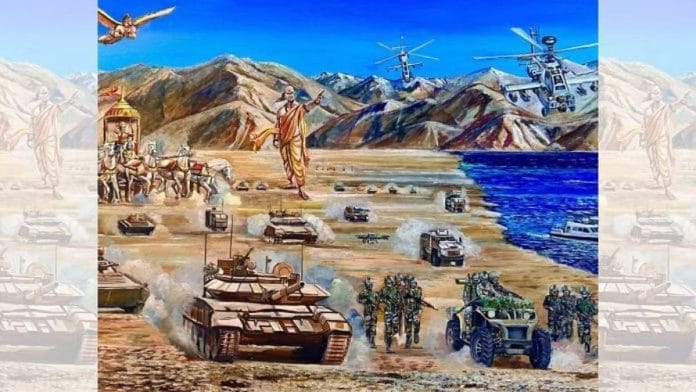New Delhi: Nearly a month after the famous portrait of Pakistan Army’s 1971 surrender at the Army Chief’s annexe in South Block was replaced with an art piece depicting Ladakh’s Pangong Tso lake, military paraphernalia and Hindu iconography, Chief of Army Staff (COAS) Gen Upendra Dwivedi Monday stressed the importance of symbolism, especially with respect to the Army’s vision.
Speaking at his annual press conference here ahead of the 77th Army Day, he said that there are two lounges of the Army Chief, one at South Block and the other at Manekshaw Centre in New Delhi, where the 1971 portrait is now placed. He added that the date 16 December, observed as Vijay Diwas every year to commemorate India’s victory in the 1971 war, was chosen to place the portrait at Manekshaw Centre as it was an “auspicious date”.
Describing the new art piece, which led to a furore on social media, Gen Dwivedi said, “Coming to the painting which is there as of now [in South Block], this has been conceptualised and made by Lt Col Thomas [Jacob] of 28 Madras Regiment, which is the younger generation [of the Army].”
“If you see the golden history of India—it has three chapters. It has British era, Mughal era and the era before that. If we wished to connect that [history] and the Army’s vision, symbolism becomes important,” he added.
The painting of the lake and its shore in the backdrop of snow-capped mountains juxtaposes history and Hindu religious iconography with modern military paraphernalia. Images of Chanakya and Garuda and a depiction of Krishna driving Arjuna’s chariot from the Mahabharata are seen alongside tanks, helicopters and boats.
The Army’s vision or blueprint for 2025 focuses on areas such as enhanced tech absorption and integrated reforms, among other things.
Referring to reforms, the Army Chief said: “So, once you look at that, my communication with my younger generation—my young officers, my jawans, is equally important.”
Thus, the surrender portrait is at the chief lounge at Manekshaw Centre and the new art piece has been put up at South Block, he added.
He pointed out that it was also being said that the new painting was mythological. “If you open Chapter 4 of the original Constitution book, the painting which is there is of Krishna and Arjuna, of the same chariot,” he said.
Referring to what the critics have been saying, Gen Dwivedi added: “It is also being said that there is a semi-clad Brahmin standing at the centre on the banks of Pangong Tso.”
“If the Indian does not know Chanakya, we need to refer back to our civilisational approach,” said the COAS, pointing out that modern technology too was visible in the painting. “Therefore, if I have to connect the past, present and future, this (the painting) symbolises that,” he added. “I give credit to the artist, who is a youngster and who is the next generation who is going to lead India tomorrow,” said Gen Dwivedi.
(Edited by Nida Fatima Siddiqui)







So another Gen ,worried about his reemployment after retirement